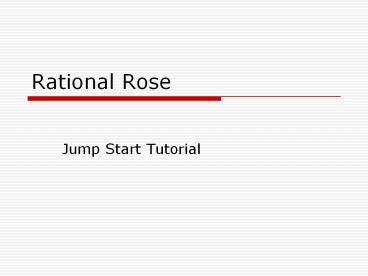Rational Rose - PowerPoint PPT Presentation
1 / 61
Title:
Rational Rose
Description:
Title: PowerPoint Presentation Last modified by: felix Created Date: 1/1/1601 12:00:00 AM Document presentation format: On-screen Show Other titles – PowerPoint PPT presentation
Number of Views:133
Avg rating:3.0/5.0
Title: Rational Rose
1
Rational Rose
- Jump Start Tutorial
2
Overview
3
Designing Complex Systems
- Three big steps in designing complex systems
- Abstract the system by building models
- Verify the model to satisfy requirements
- Transform models into implementation
4
What Rational Rose does?
- Build visual models to analyze and design
components - The models acts as a blueprint of the software
system - Uses the UML Standard
5
Features
6
Types of Diagrams
- Use Case Diagram
- Class Diagram
- Data Model Diagram
- State Machine Diagram
- Interaction Diagram
- Component Diagram
- Deployment Diagram
7
Use Case Diagram
- A high-level view of how a system is used
- Specify the behavior of a system as implemented
8
Use Case Diagram
- Use Case
- A sequence of events performed by the system
- Actor
- A system user who interact with the system
9
Creating a Use Case Diagram
10
Rational Software
Programs
Rational Rose Enterprise Edition
Start Menu
11
Click Cancel
12
Expand Use Case View
13
Right-click Use Case View
14
Choose New -gt Actor
15
Type in LibraryUser
16
Right-click Use Case View
17
Choose New -gt Use Case
18
Name it Check Book Availability
19
Do the same to add a Librarian Actor, Use
Cases Checkout Book Renew Book Reserve
Book Re-shelf Book Return Book
20
Right-click the Main Use Case Diagram, Click
Rename, and type in Library Transactions
21
Double-click Library Transaction to bring up the
Use Case Diagram
22
Maximize the Use Case Diagram
23
Drag LibraryUser and Librarian to the Use Case
Diagram
24
Likewise, drag all the Use Cases to the
diagram one by one
25
Click the Unidirectional Association arrow (solid
line arrow)
26
Click and hold the mouse click on LibraryUser,
drag it over to Return Book, then release the
mouse
27
Return Book Use Case is then associated to
Library User. Do the same to create Association
arrows as shown in the diagram.
28
Click the Dependency arrow (dotted line arrow)
29
Drag from Reserve Book to Check Book Availability
30
Right click the Dependency arrow
31
Choose Open Specification
32
Open the drop down box
33
Choose Include
34
Then click OK
35
Drag ltltincludegtgt above the arrow
36
(No Transcript)
37
Class Diagram
- Contain icons representing classes, interfaces
and their relationship
38
Class Diagram
- Class name
- Attributes
- Operations
39
Creating a Class Diagram
40
Right click Use Case View
41
Choose New -gt Class Diagram
42
Name it LibraryClasses
43
Double-click LibraryClasses and maximize the
diagram
44
Right click Use Case View
45
Choose New -gt Class
46
Name it Book
47
Do the same and create these classes
Patron Student Faculty
48
Drag them into the class diagram
49
(No Transcript)
50
Right-click Book, Select New Attribute
51
Name it Title
52
Add the remaining attribute Author ISBN Publisher
Status
53
Right-click Book, Select New Operation
54
Name it isAvailable
55
Enter the rest of the attributes and operations
as shown in the diagram
56
Click the Generalization arrow
57
Drag it from Student to Patron
58
Do the same for Faculty
59
(No Transcript)
60
Drag the arrow head of the Faculty class arrow of
the Student class
61
We have built an inheritance tree































